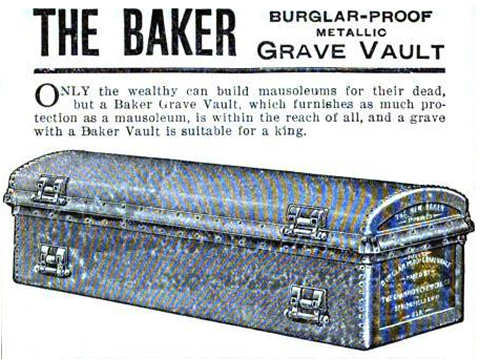14 strange coffins and graveyard inventions that were used to bury people many years ago.

1. Safety Coffin

In the 19th century, people were terrified of being buried alive. This fear led to the invention of the safety coffin. These devices had a bell tied to a string that led down into the coffin. If you were buried alive, you could tug the string to ring the bell alnd alert those above. There was also a hatch that would let fresh air into the coffin, allowing you to breathe until rescue came.
2. Cast-Iron Coffin

In 1848, inventor Almond D. Fisk patented his Cast-Iron Coffin. When someone died far away from home or in a foreign country, transporting the dead body home could take weeks. The corpse would be sealed inside a cast-iron coffin which was in the shape of an Egyptian sarcophagus. This would preserve it while it was in transit. These cast-iron coffins also had hinged faceplates, which you could open to see the face of the deceased.
3. Corpse-Preserving Casket

Invented in 1871 by John Gravenstine, this was basically an airtight coffin with an icebox on top. It was designed to keep the corpse refrigerated.
4. Escape Vault

Sometimes coffins or vaults would be fitted with a way to escape. If someone was buried alive, they could turn the handwheel to open this vault and get out. This vault was invented by Thomas Pursell and is located at Wildwood Cemetery in Williamsport, Pennsylvania. Pursell was buried there in 1937, but so far, he has not managed to escape.
5. Reusable Coffin

In the late 1700s, some countries used reusable coffin. The wooden coffin had a trap door in the bottom. Corpses were wrapped in sacks and placed in the coffin. After the funeral, the coffin was held over the grave, the trap door was released and the dead body would drop into the hole. Then, the coffin could be reused at other funerals.
6. Pauper’s Grave

A coffin-shaped hole for pauper burials in Youghal, Ireland. An empty coffin was once stored here for poor people who could not afford a proper burial. Their bodies were temporarily put in the coffin during the funeral. Then, the corpse would be carried to the grave and buried in a shroud. The coffin would remain in the hole to await the next pauper.
7. Caged Graves

In the early 19th century, grave robbers would dig up fresh corpses and sell them to medical schools for scientific research. It became a big problem, so to deter the grave robbers, a heavy iron cage was sometimes placed over graves to protect them. Theese cages were called “Mortsafes”. After a few weeks, when the body was decomposed and no longer of interest to the grave robbers, the cage would be removed and used on a new grave.
8. Coffin Torpedo

The Coffin Torpedo was another way to deter grave robbers. It kind of like a landmine or a modified firearm that shot lead balls. When sometone tried to open the coffin, it would trigger the coffin torpedo and blow up the grave robber.
9. Charlie Chaplin

Picture of Charlie Chaplin’s coffin that was sent to his family after grave-robbers stole it demanded a ransom. The robbers were eventually caught and charged with extortion “disturbing the peace of the deadâ€.
10. Cimitero Monumentale

Just a glimpse of some the breathtaking graves that can be found in Cimitero Monumentale in Milan, Italy.
11. Angel of Grief

Angel of Grief is an 1894 sculpture by William Wetmore Story which serves as the grave stone of the artist and his wife at the Protestant Cemetery in Rome.
12. Barrel of Rum

In the Old Burying Ground, in Beaufort, North Carolina, visitors frequently leave small gifts and trinkets at the unusual gravesite of the little girl buried in a barrel of rum. According to the legend, a young girl traveled to England with her father who promised the child’s mother to return her safely home. Sadly, on the return journey, the young girl died at sea. Desperately wanting to keep his promise to return home with his daughter, the girl’s father purchased a barrel of rum from the ship’s captain. He placed his daughter’s lifeless body in the barrel of rum and returned her to Beaufort for burial at home.
13. Waiting Mortuary

To avoid premature burials, dead bodies were sometimes kept in a waiting mortuary. They were laid out on tables and attendants would watch day and night for signs of life. These were most popular in 19th century Germany. Sometimes strings attached to bells would be tied around the fingers and toes of the corpse. If there was any movement, the bell would alert attendants that one of the dead bodies was alive.
14. Miniature Coffins

In 1836, three boys in Edinburgh, Scotland discovered a strange cache of miniature coffins concealed on a hillside above the city. Each coffin contained a wooden doll that had been hollowed from a solid piece of wood. Coffin dimensions vary but those now accessible for study are 3.7 to 4.1 inches long, 0.7 to 1.2 inches wide, and 0.8 to 1.0 inches deep with their lids in place.
15. Baker Burglar-Proof Metallic Grave Vault








Nice grave ideas :-)